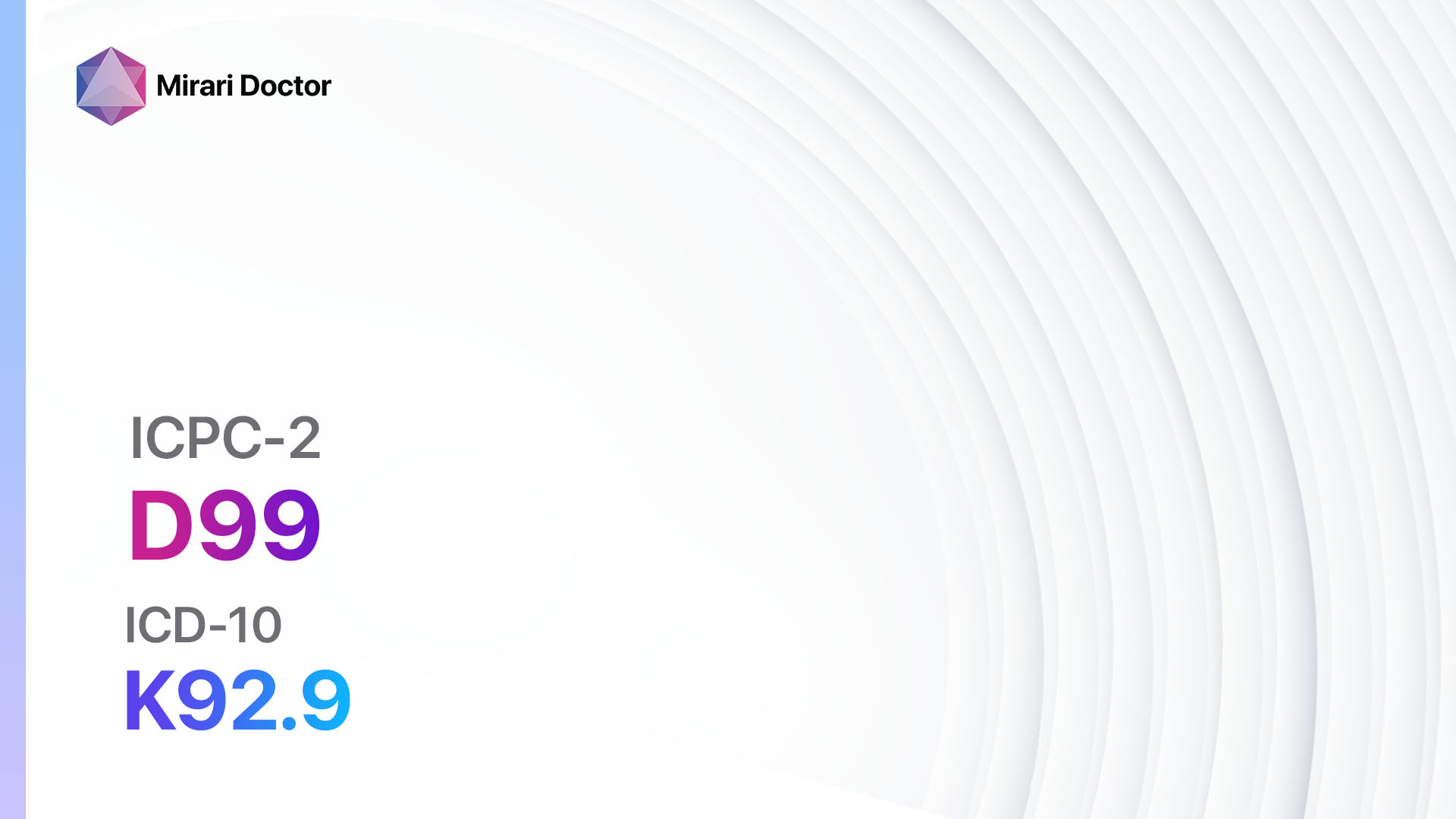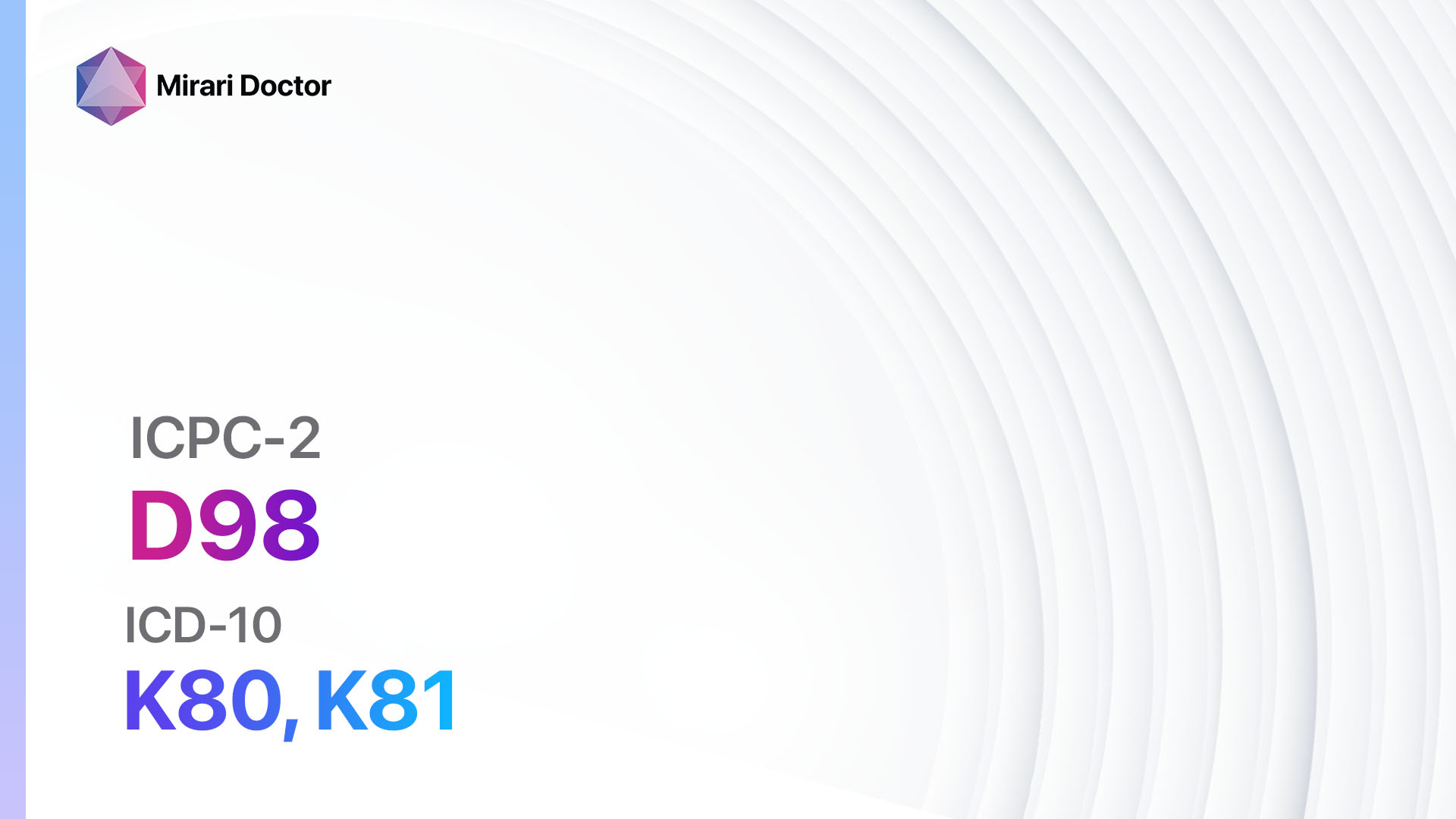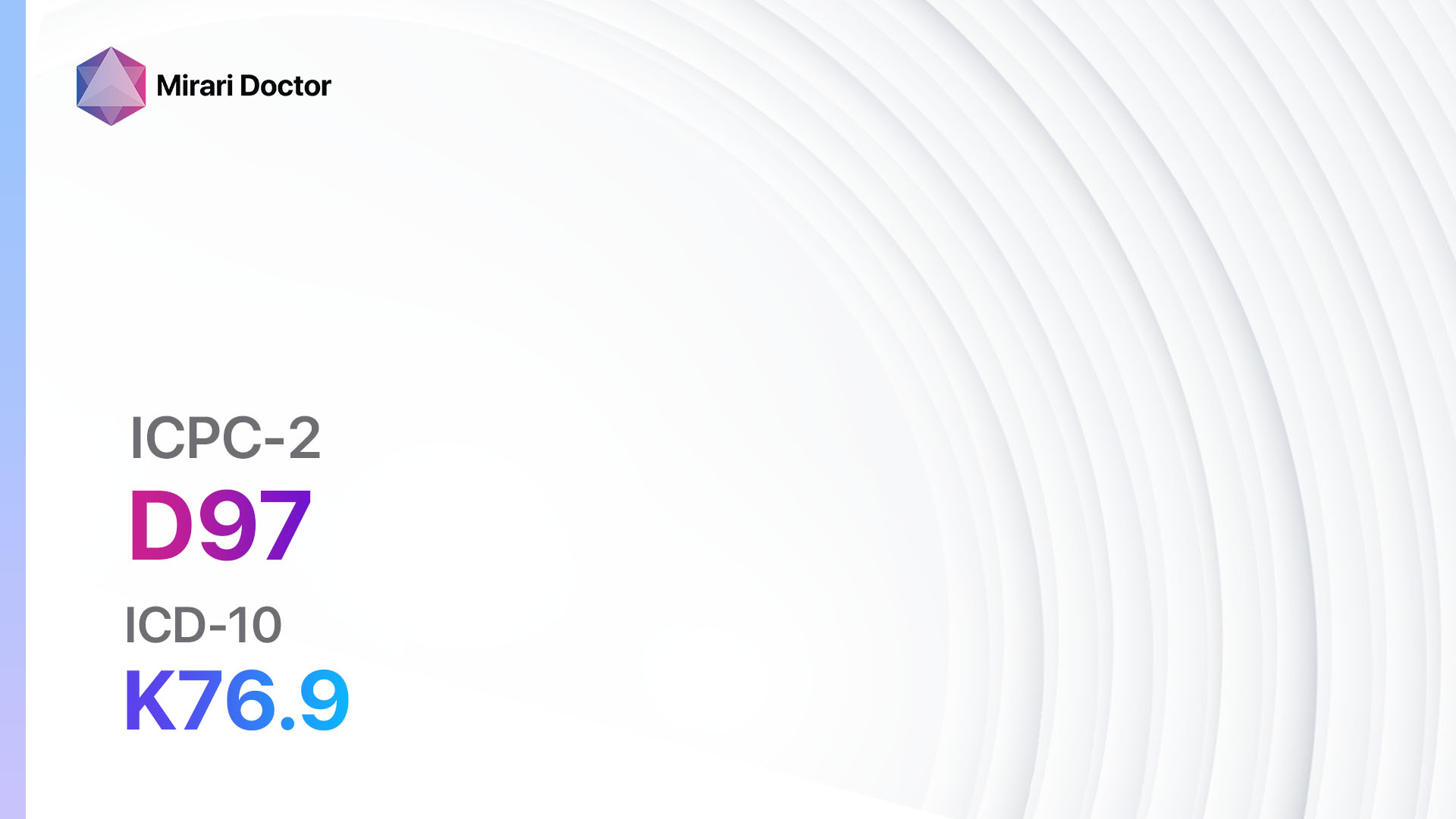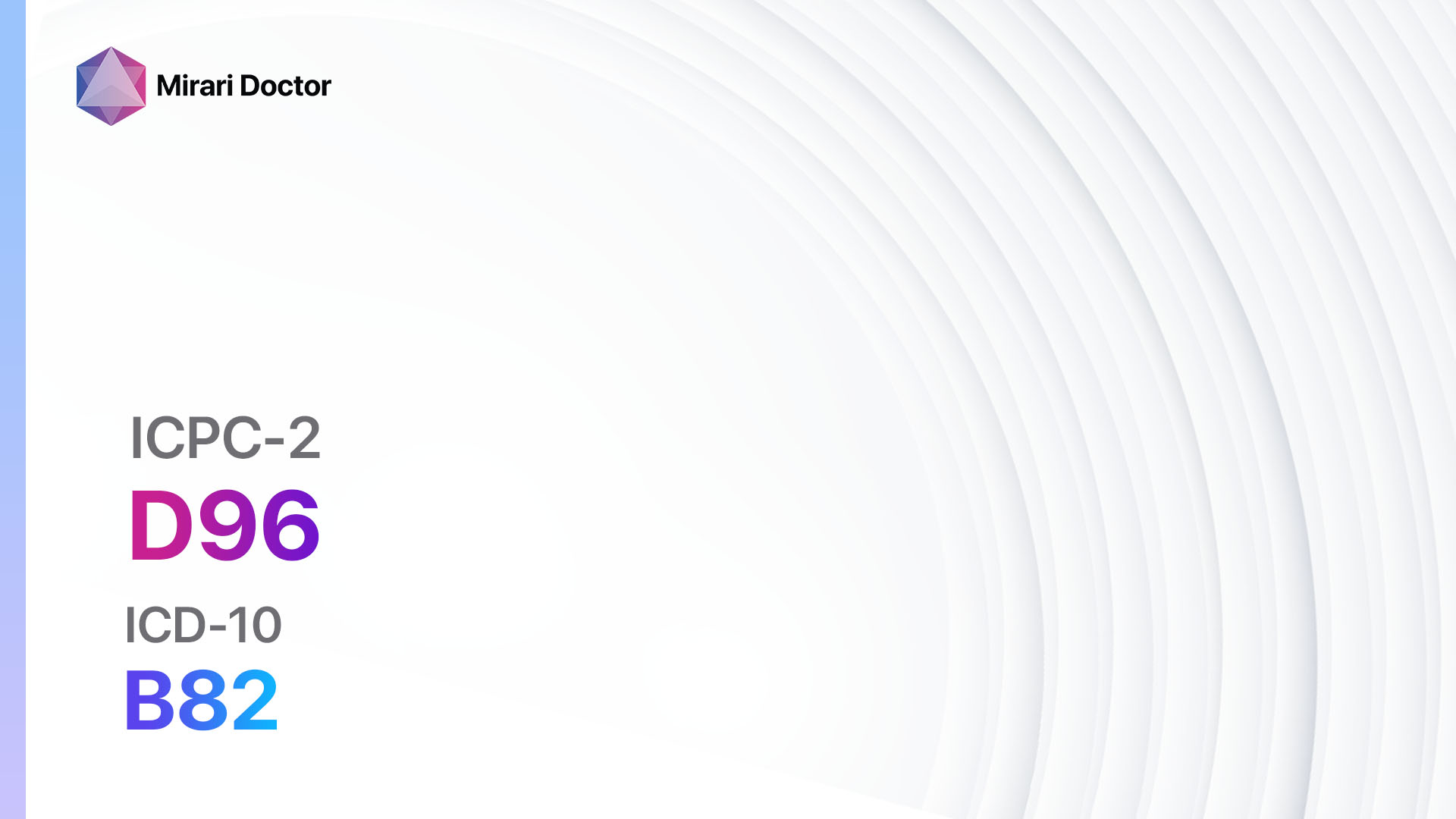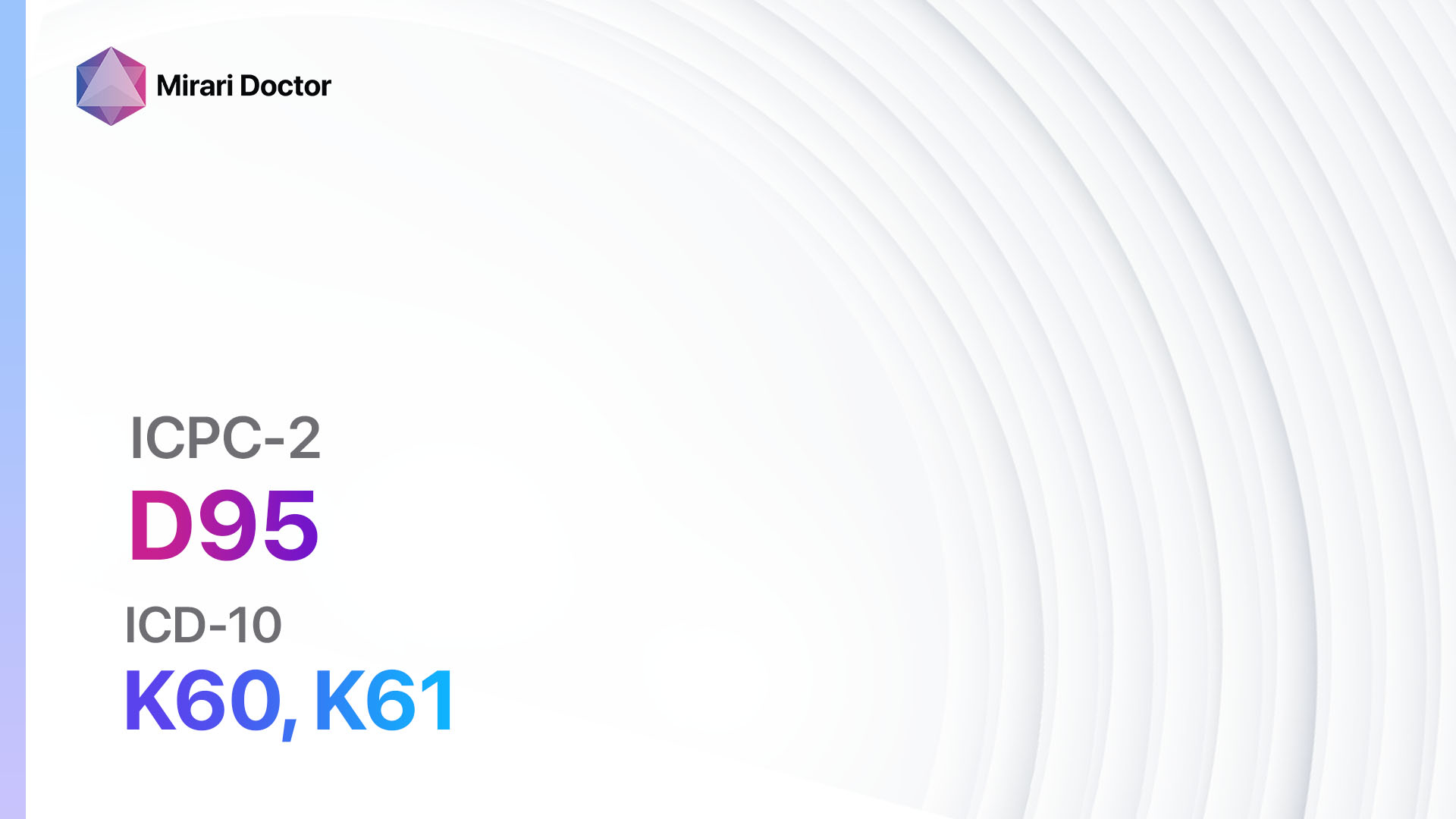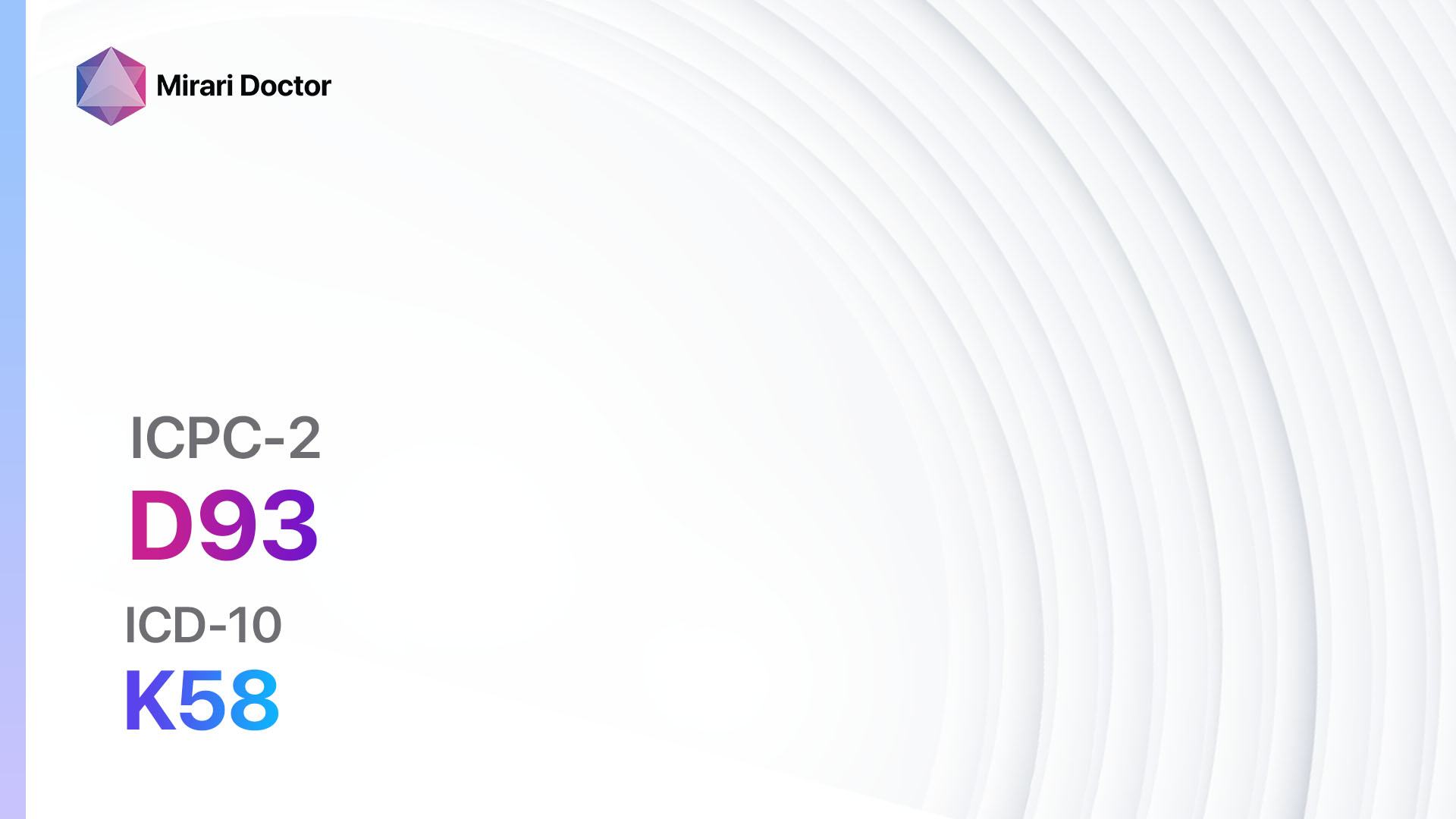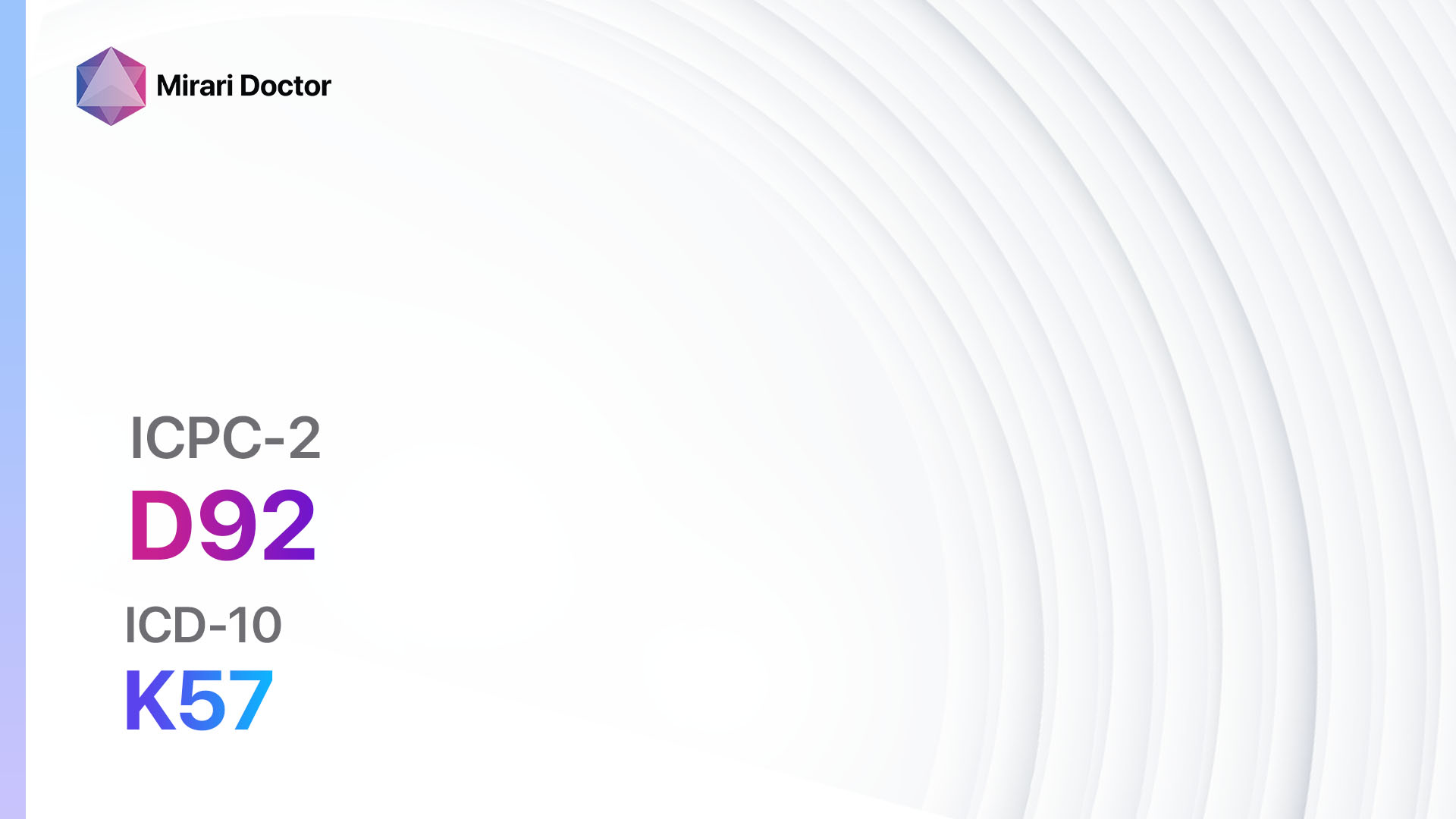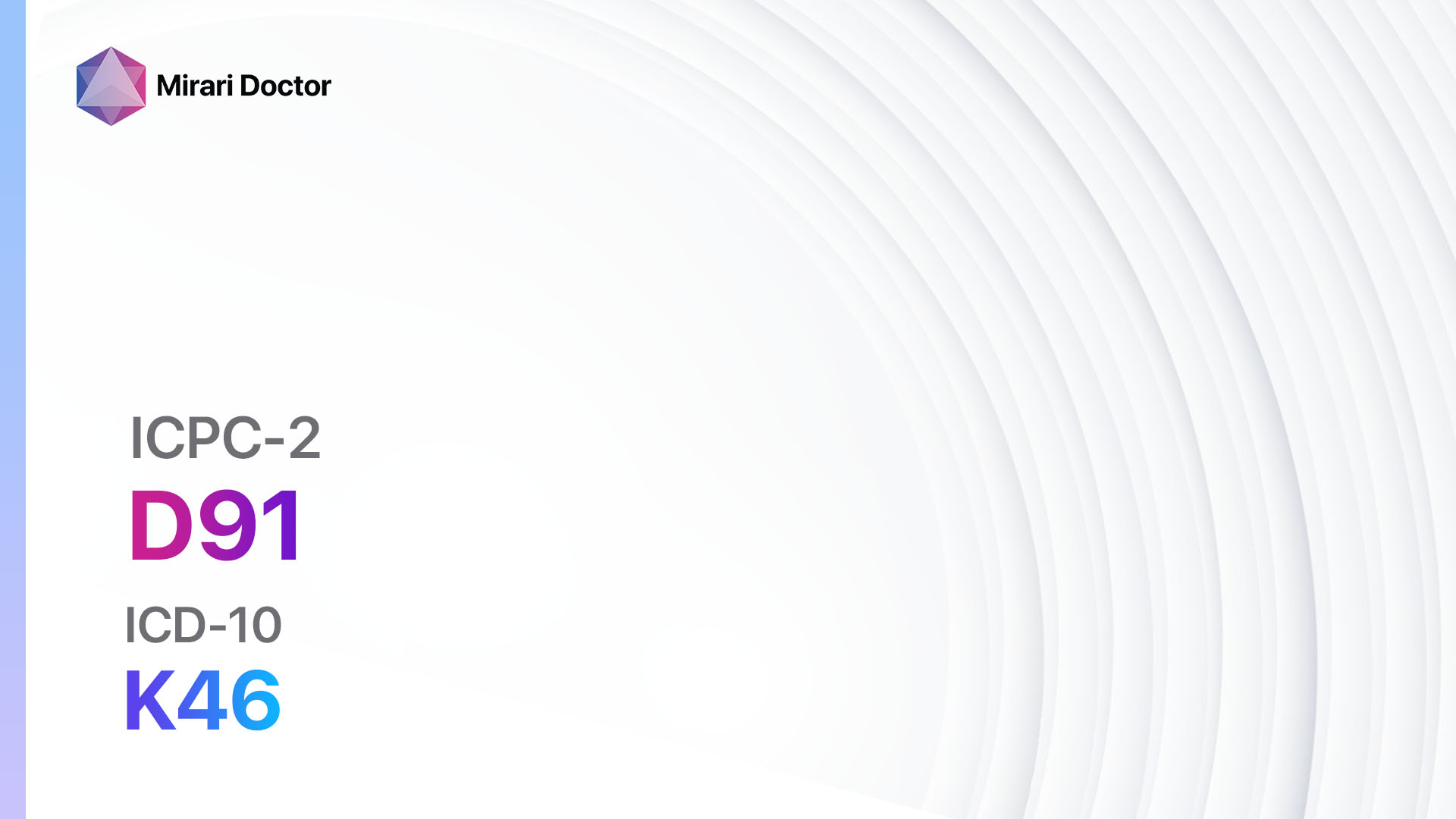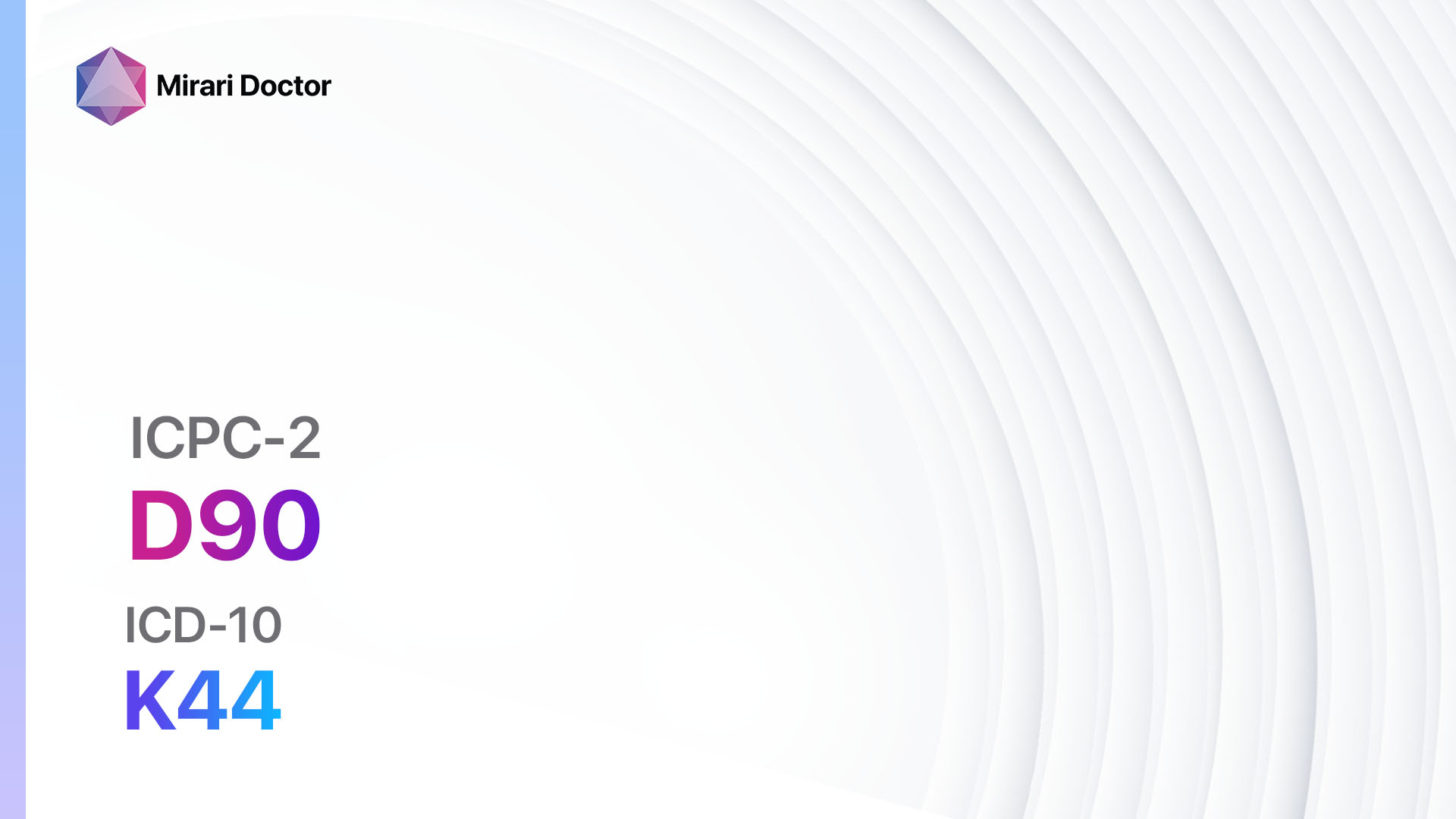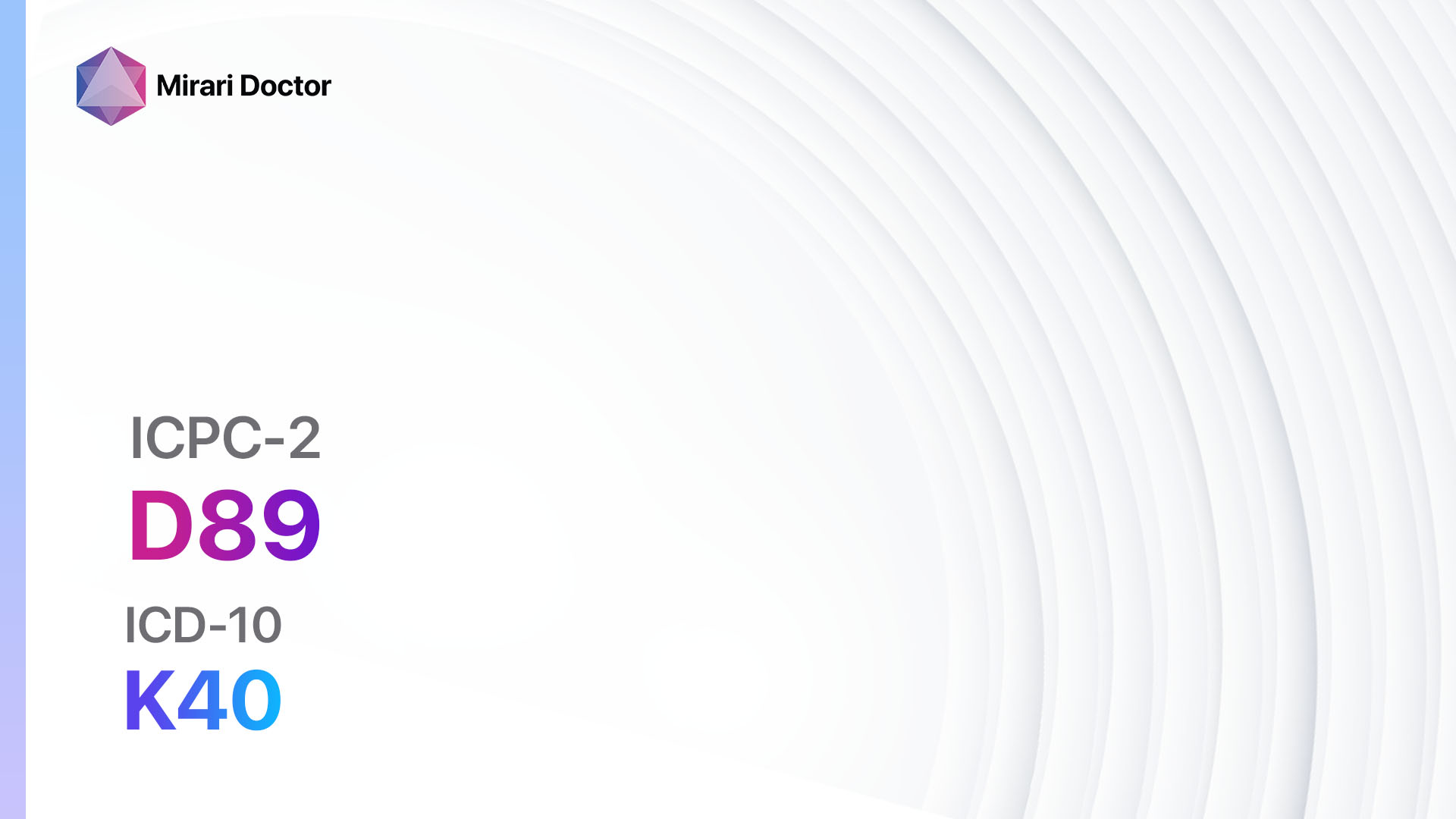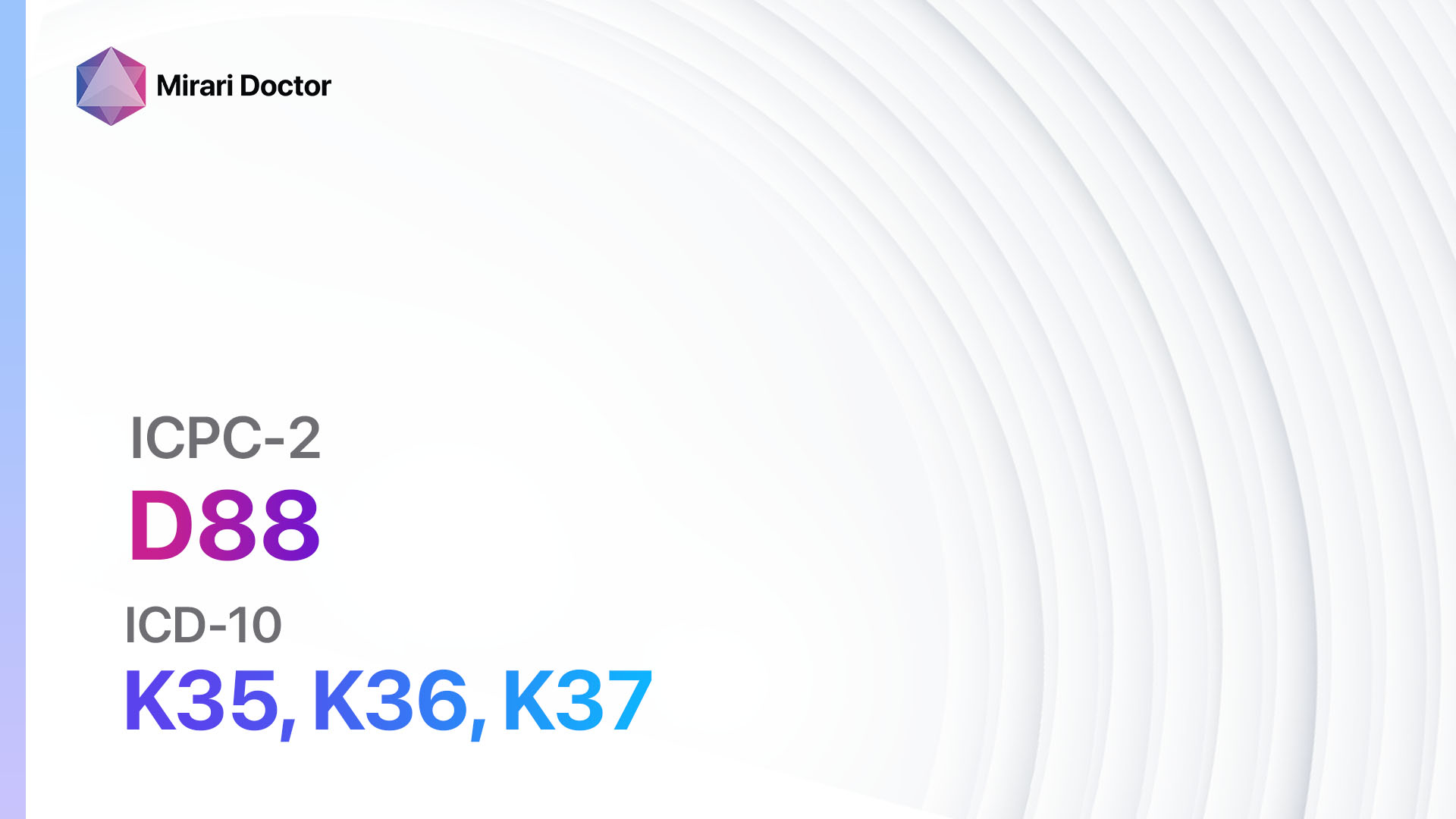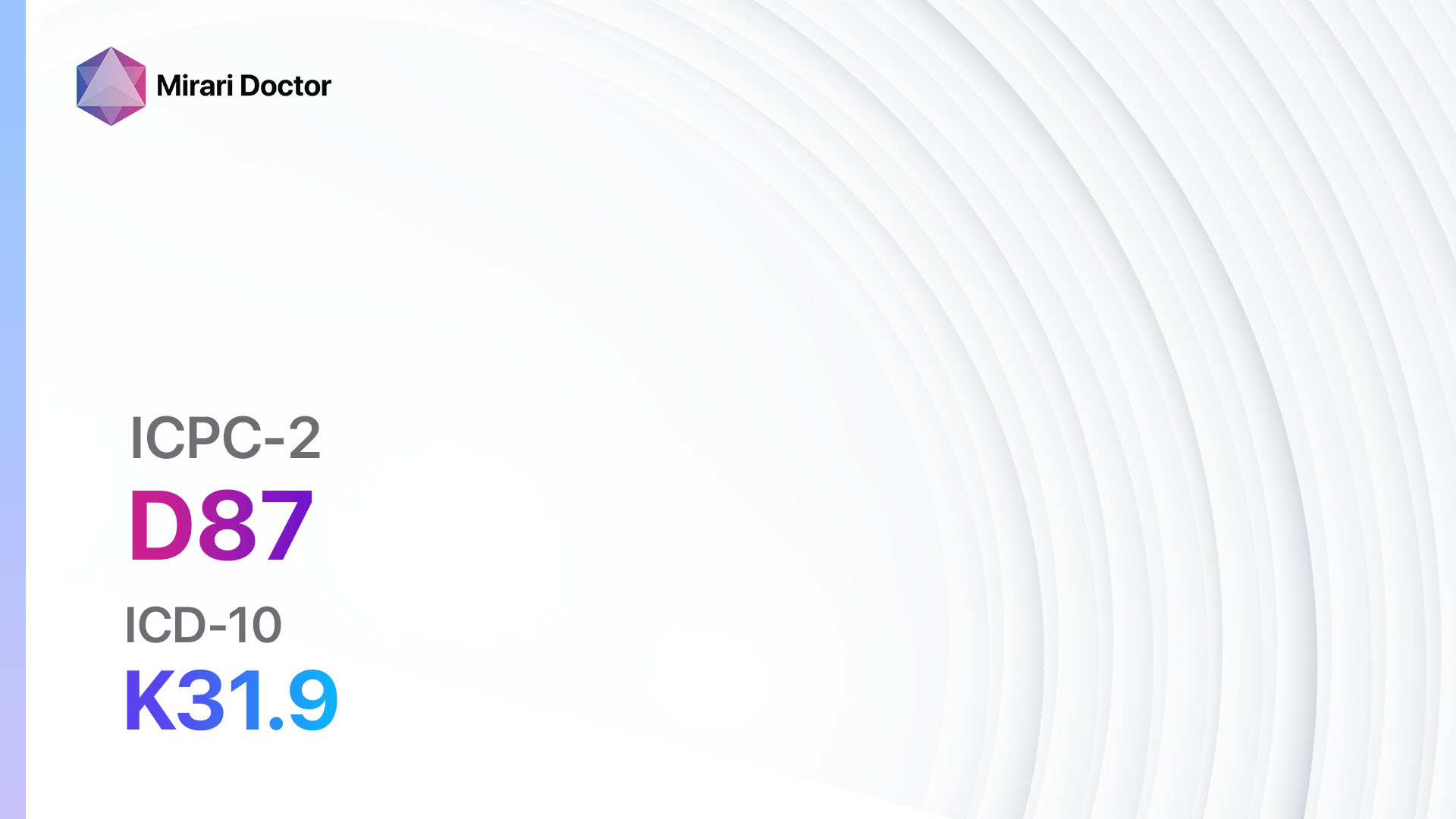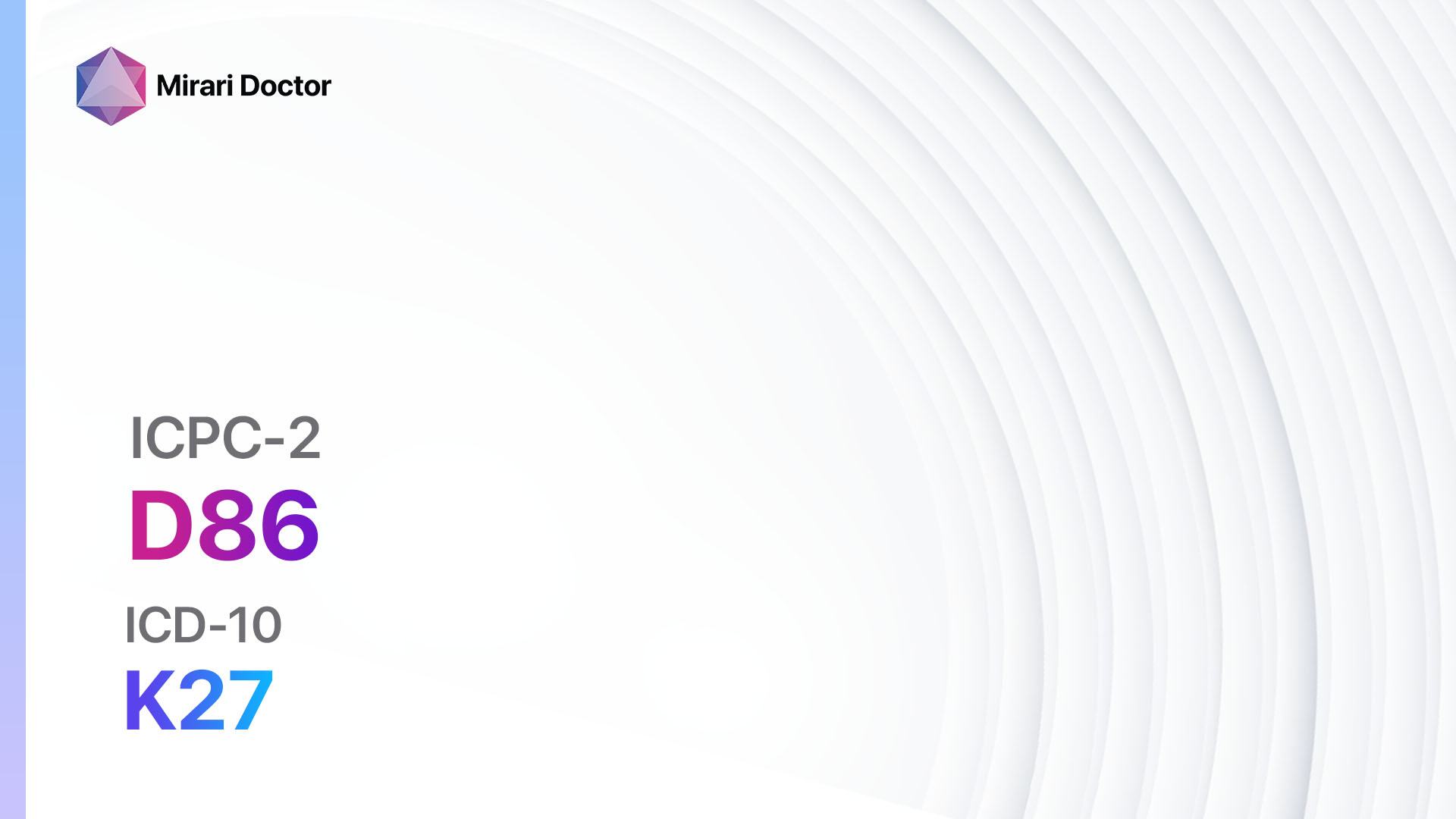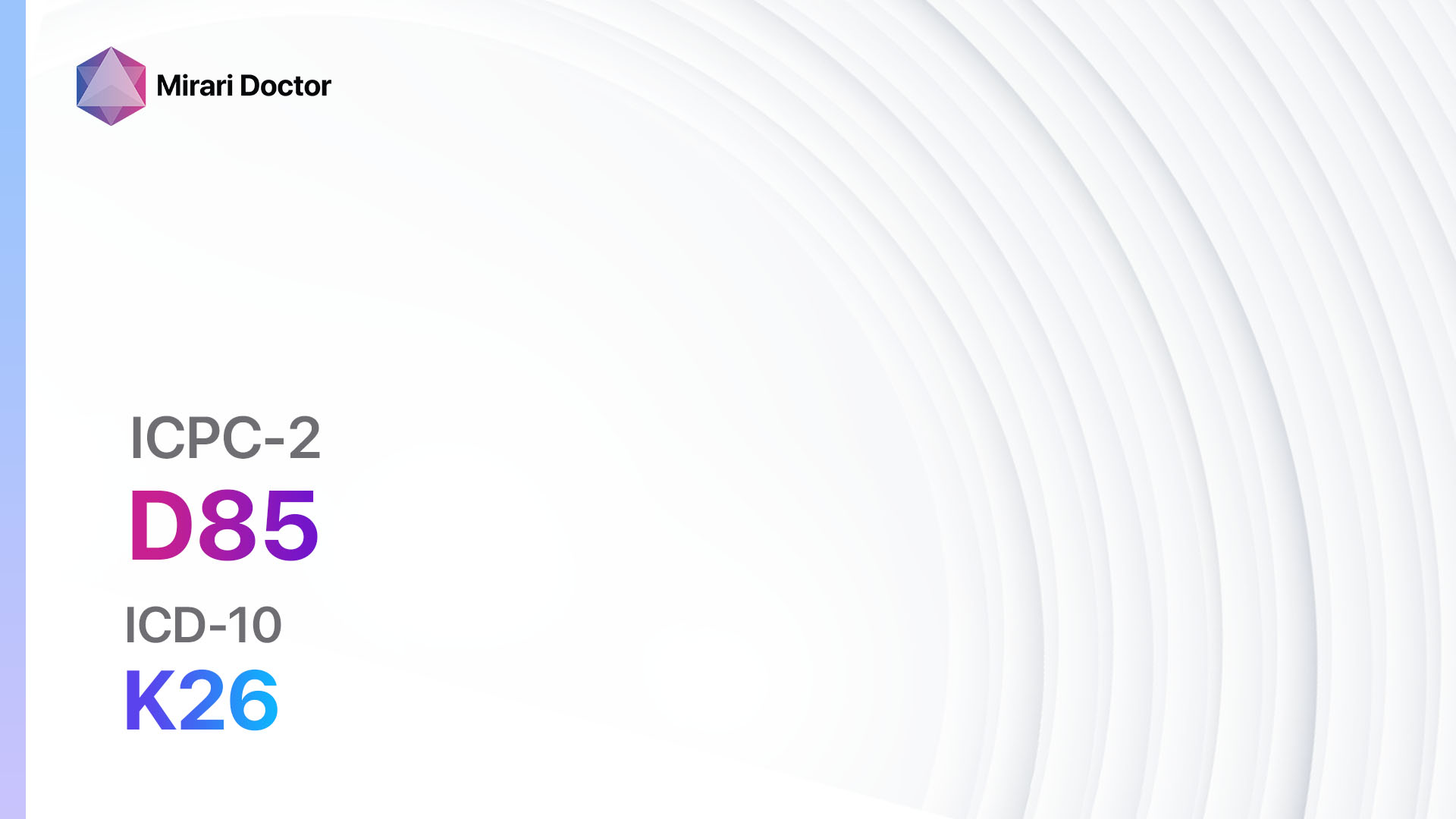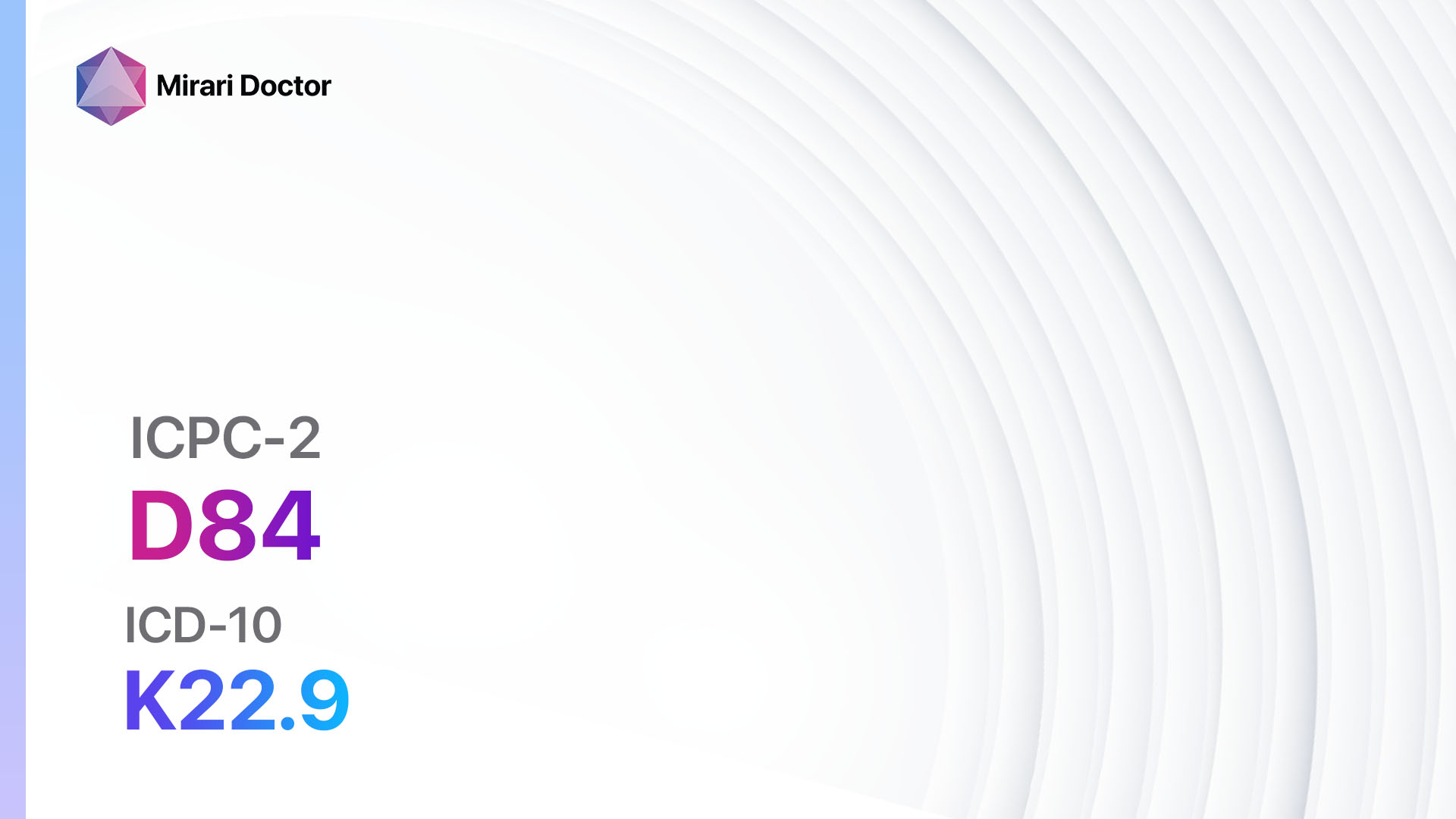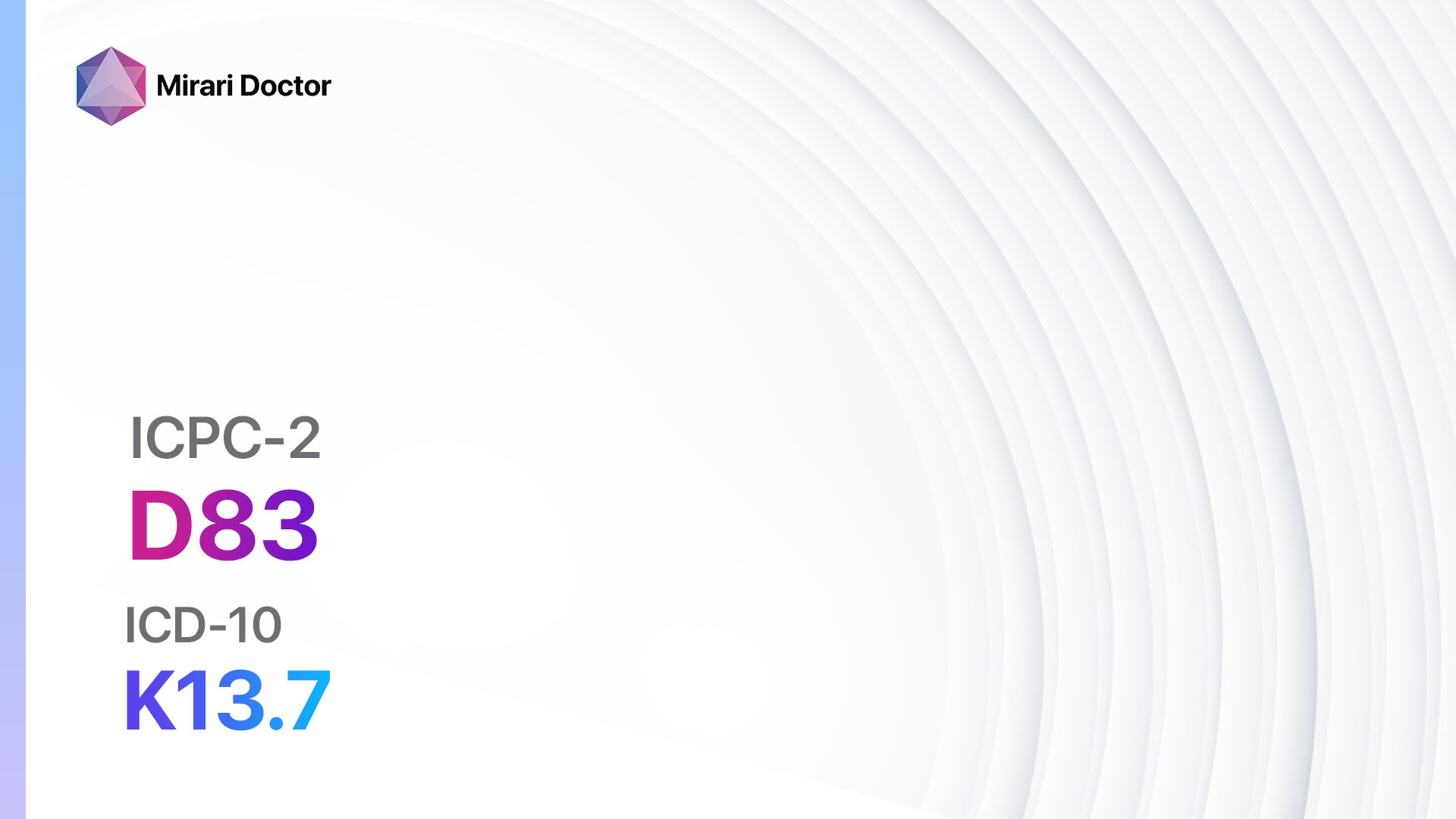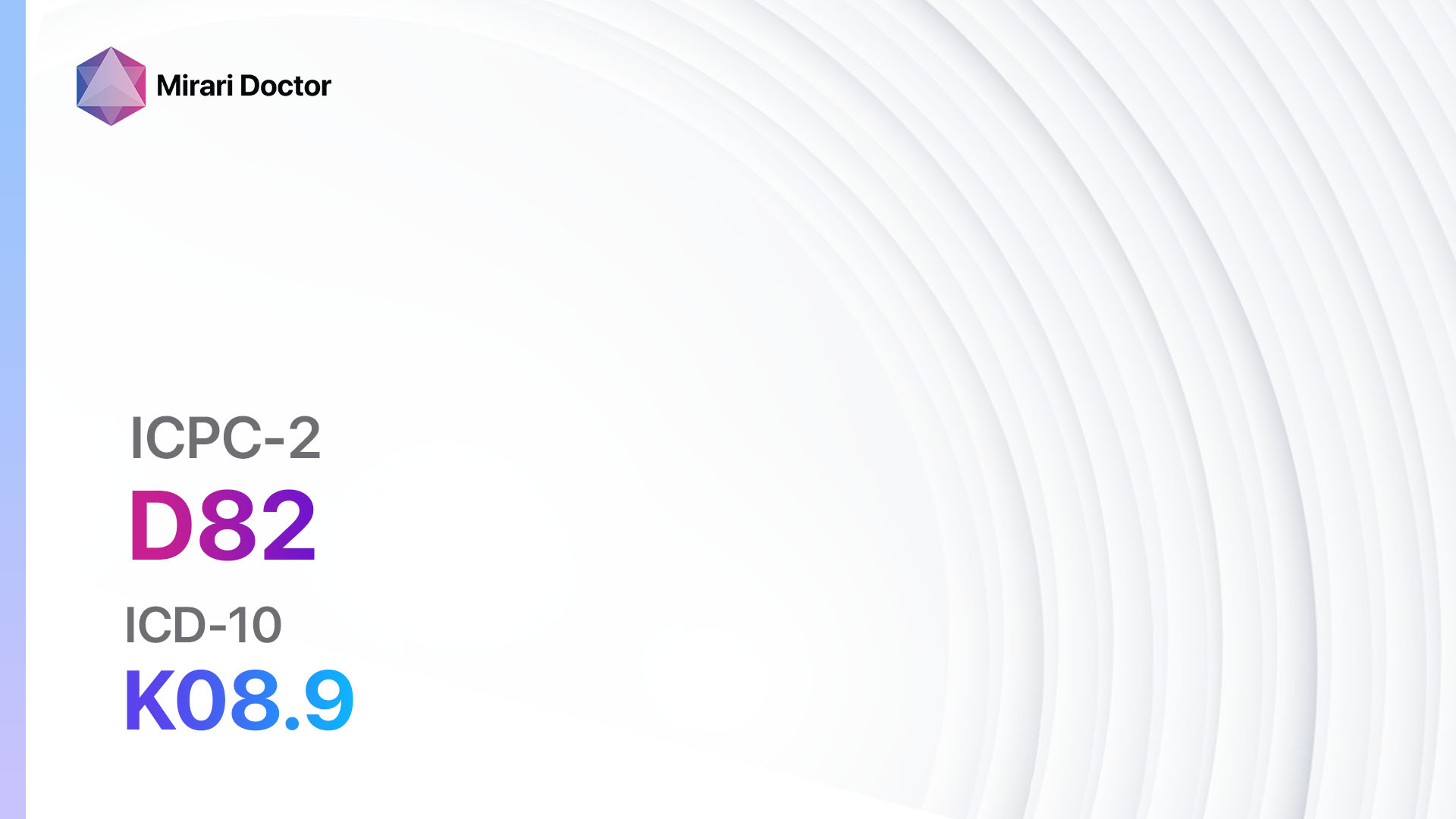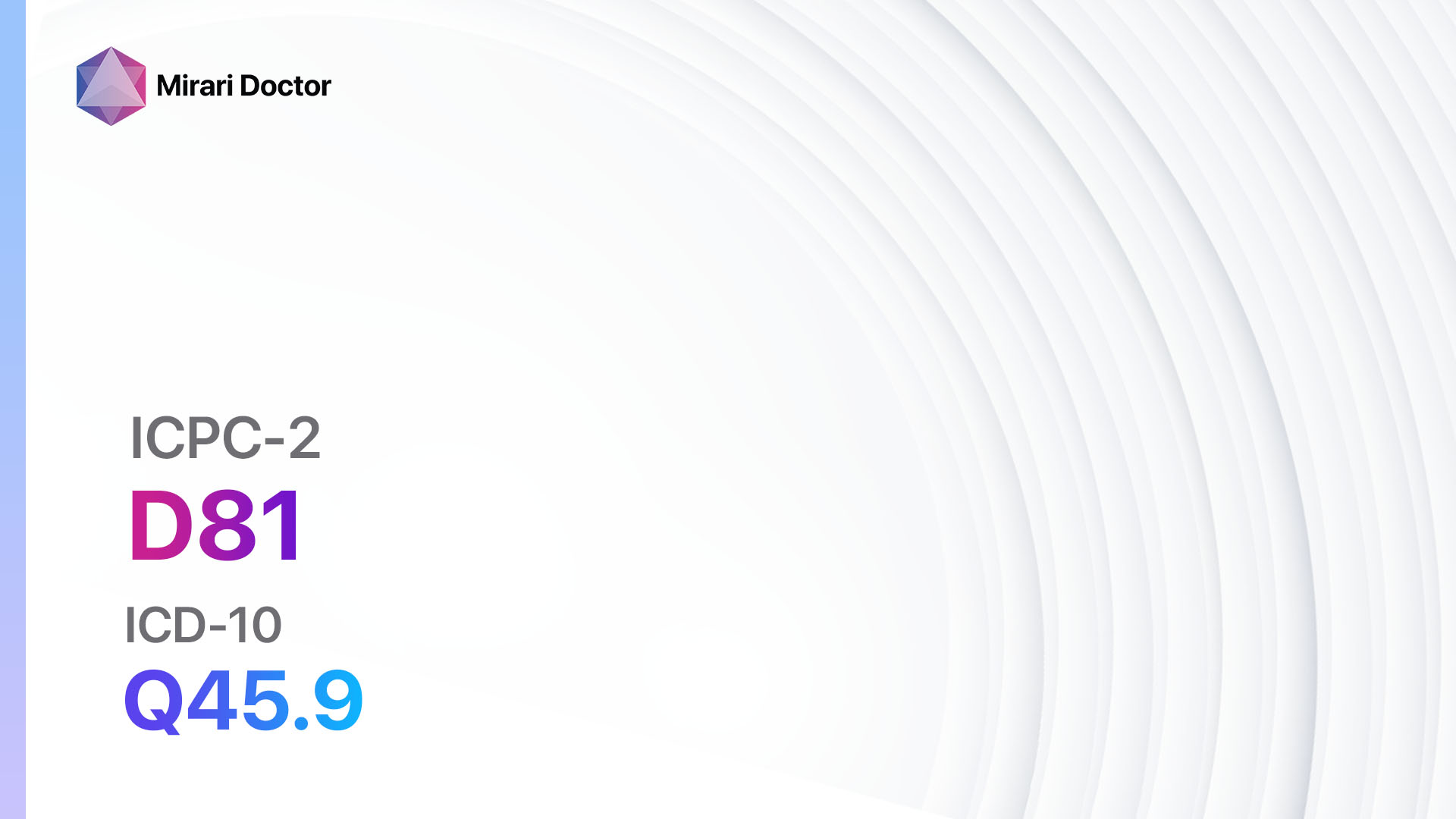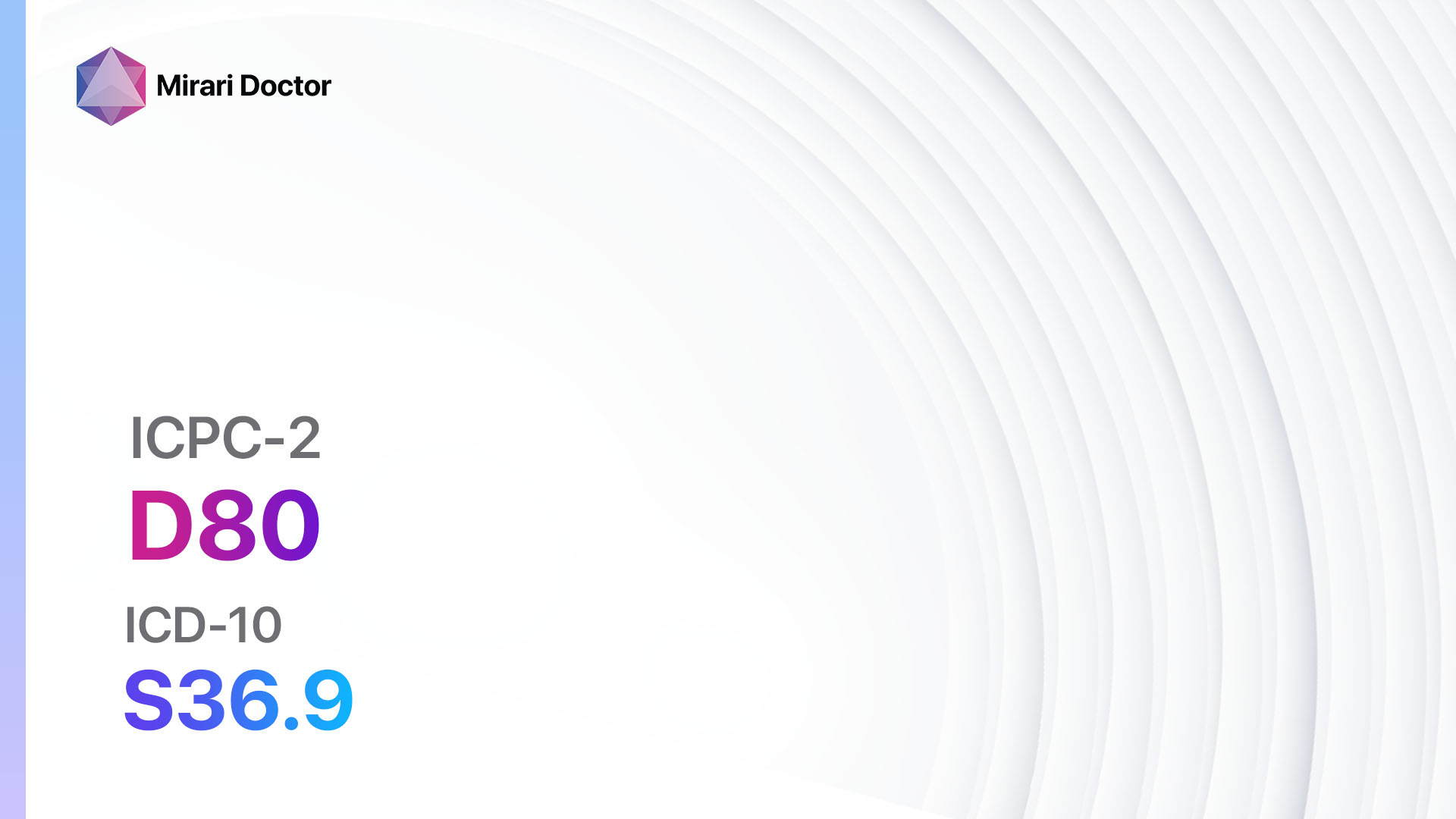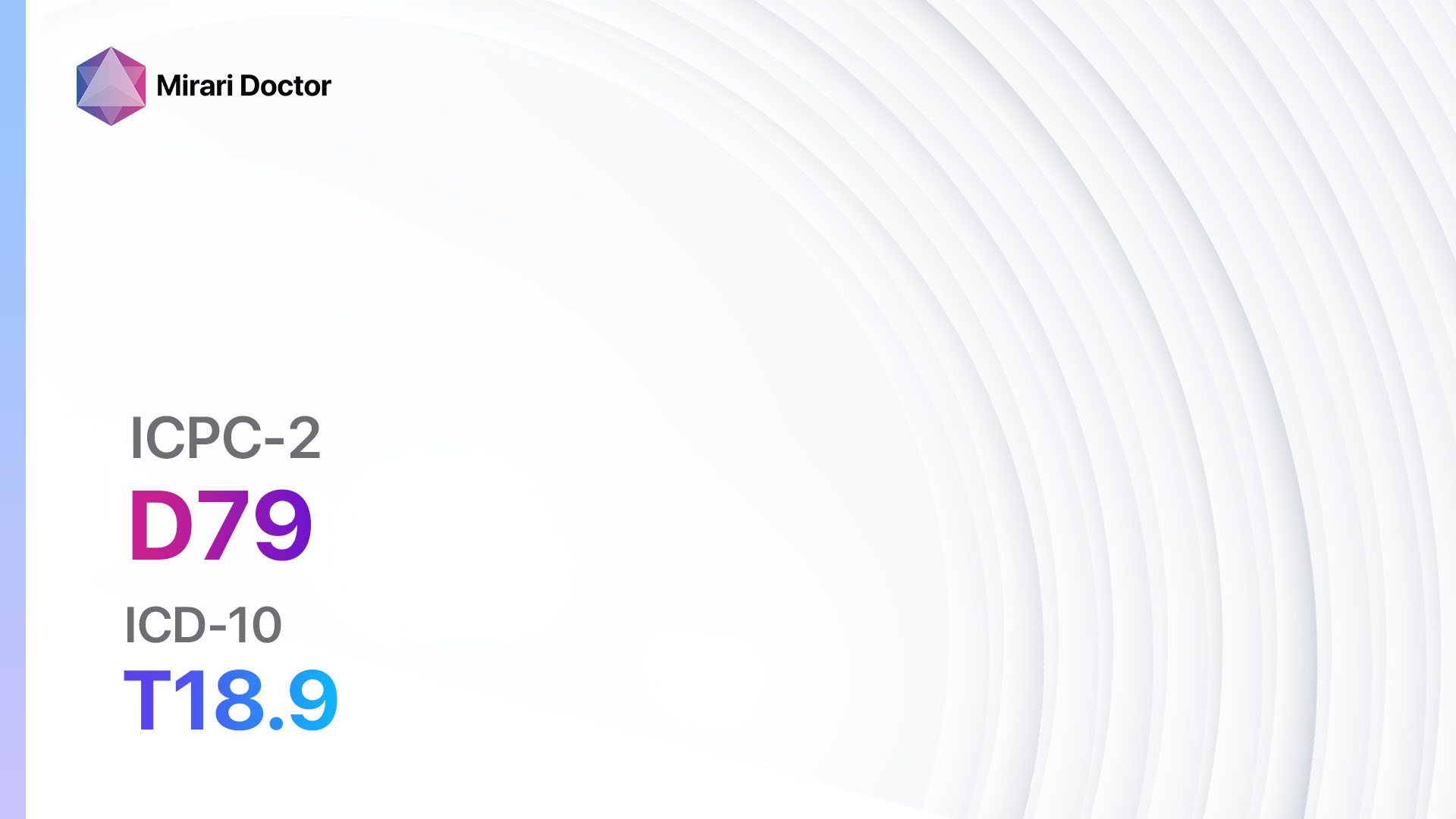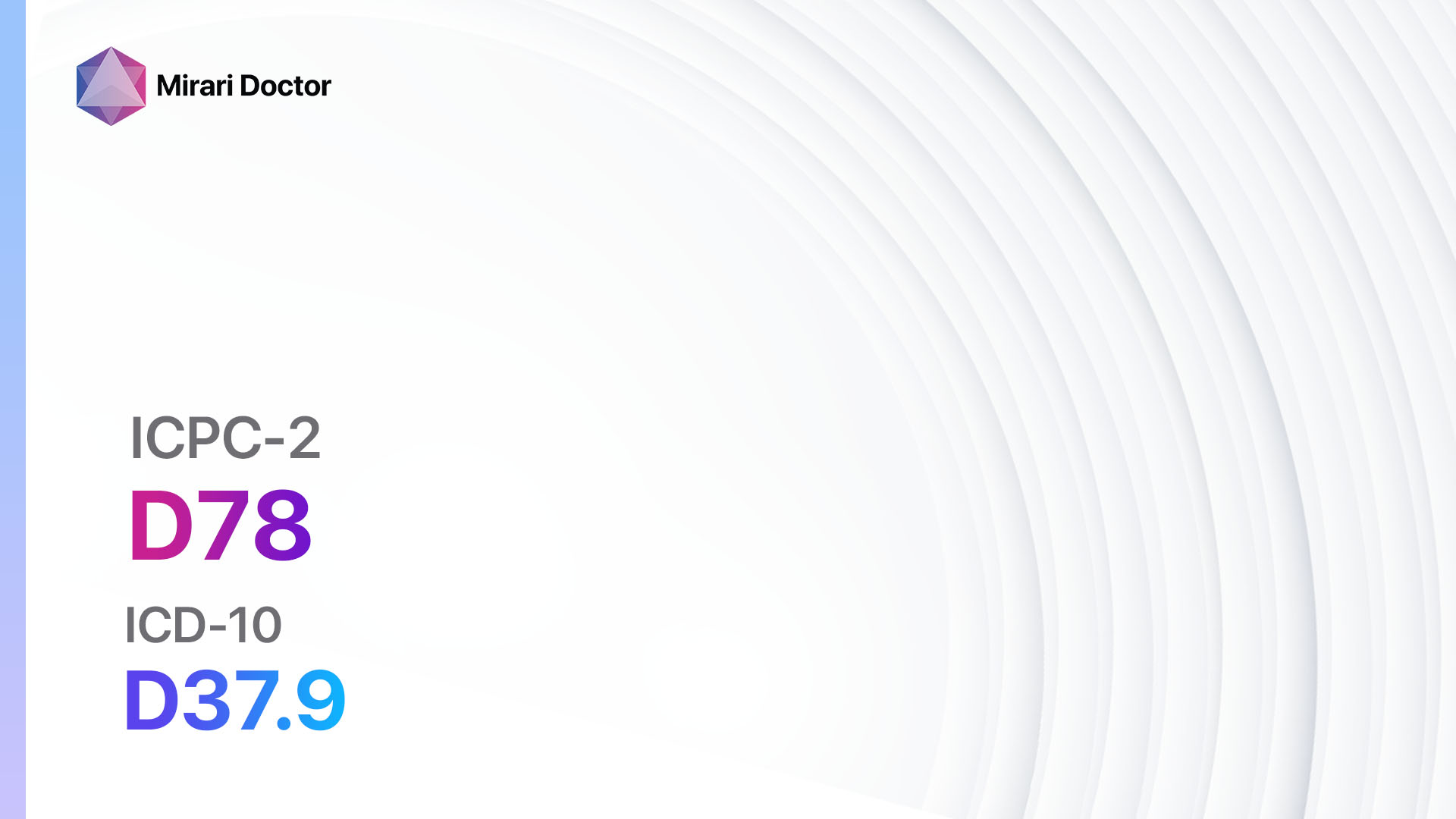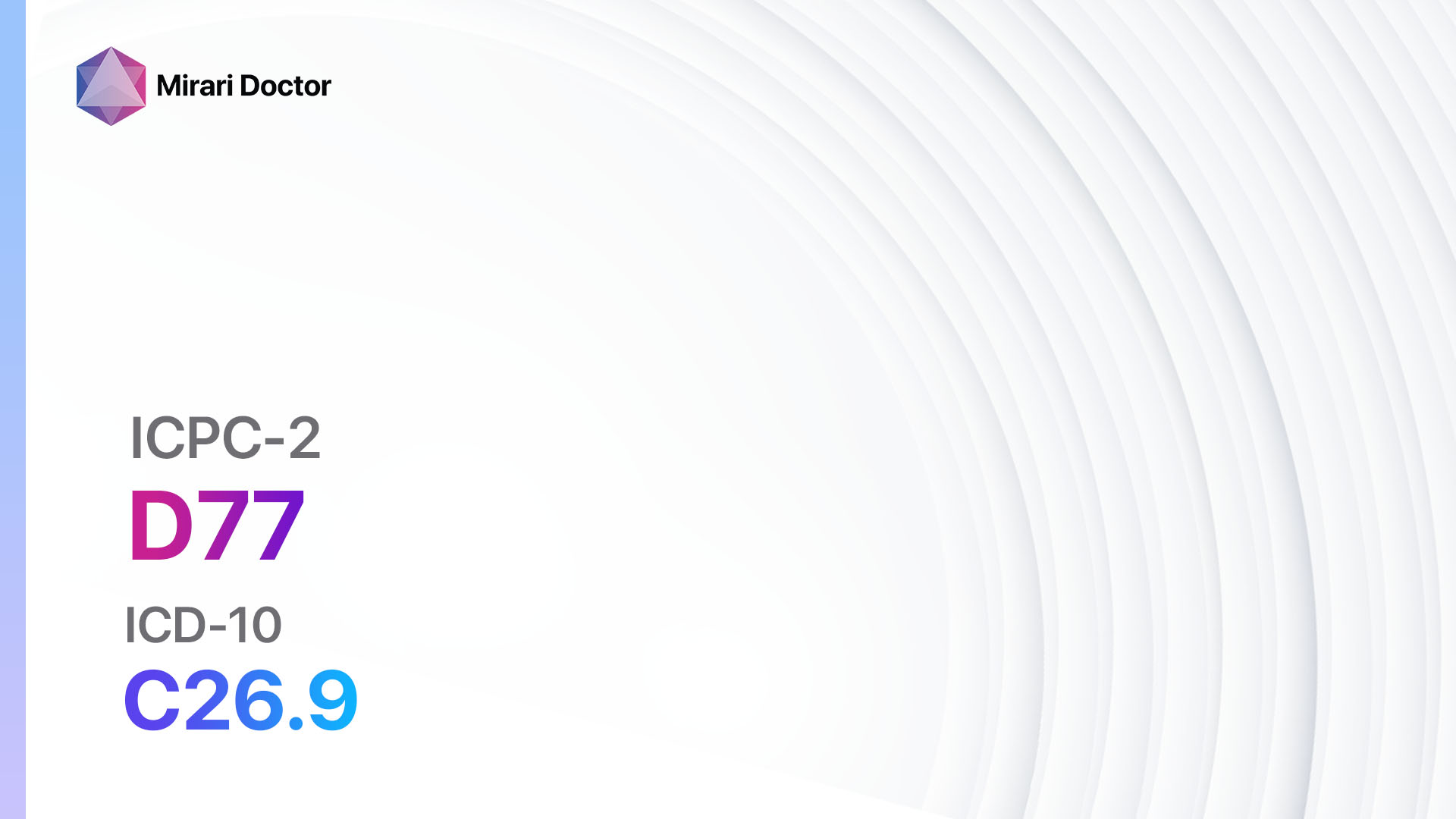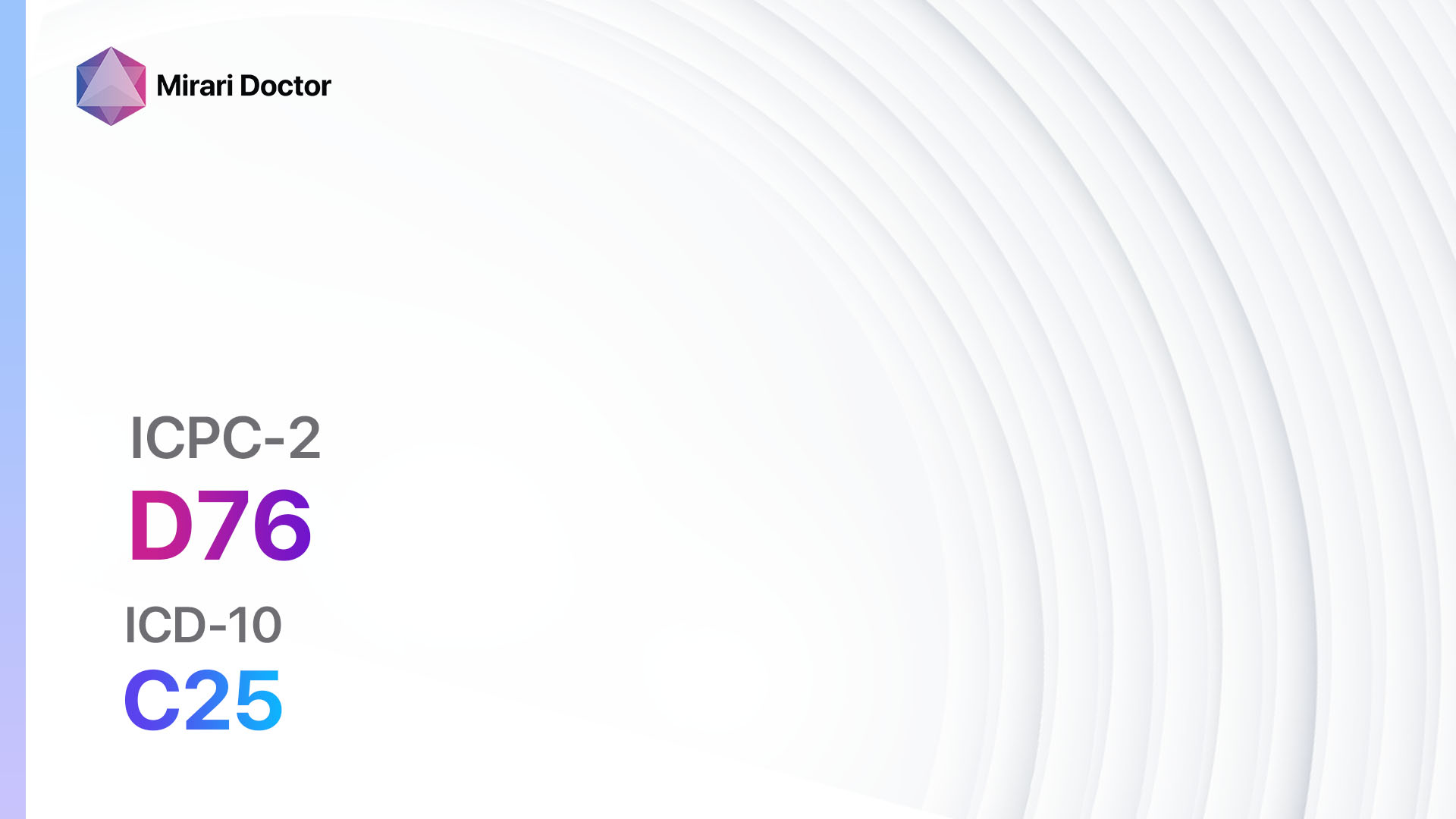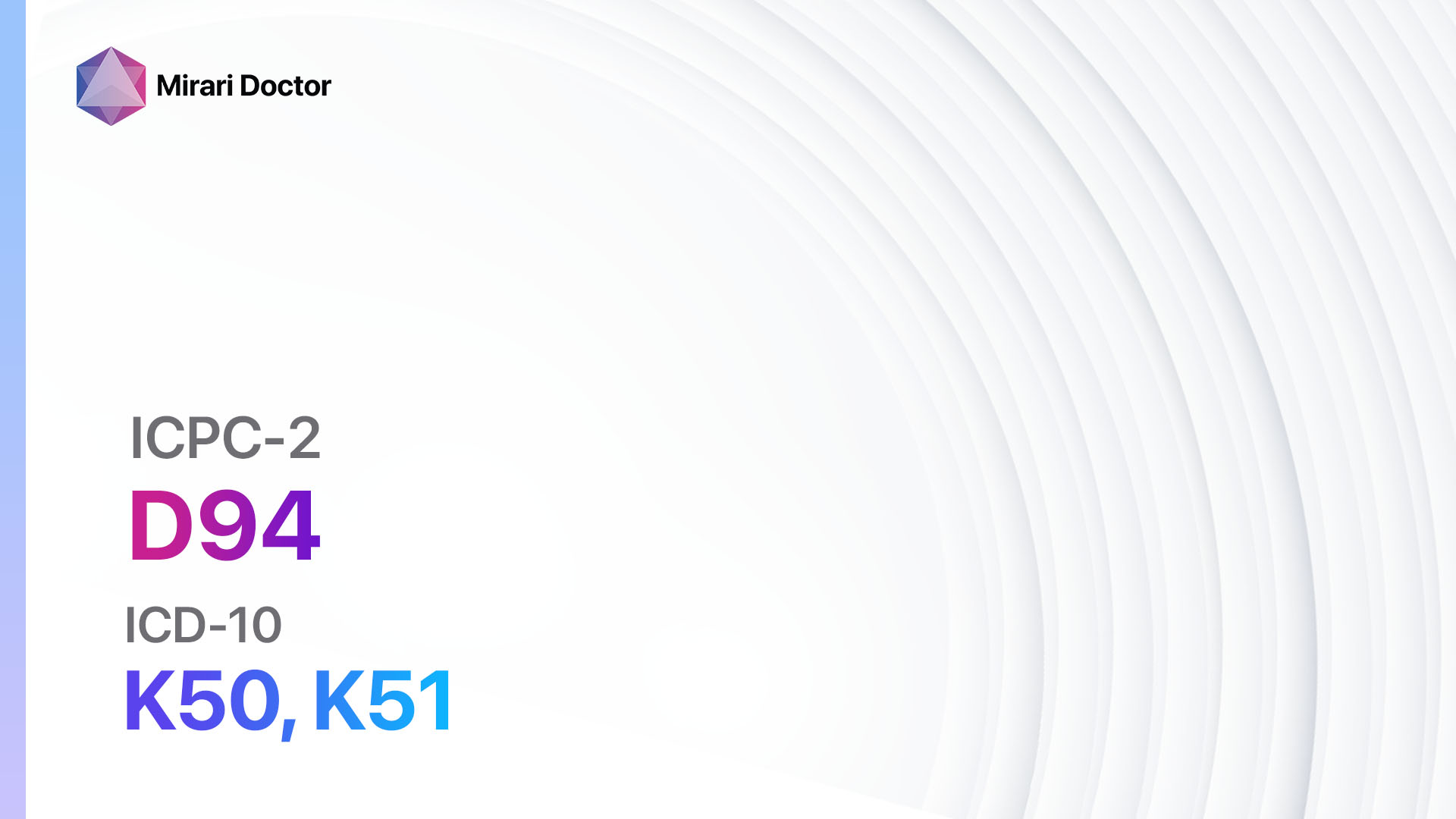
Introduction
Chronic enteritis/ulcerative colitis is a chronic inflammatory bowel disease that affects the lining of the colon and rectum. It is characterized by symptoms such as abdominal pain, diarrhea, and rectal bleeding[1][2]. The aim of this guide is to provide a comprehensive overview of the diagnostic steps, possible interventions, and lifestyle modifications for managing chronic enteritis/ulcerative colitis.
Codes
- ICPC-2 Code: D94 Chronic enteritis/ulcerative colitis
- ICD-10 Code: K50 Crohn disease [regional enteritis], K51 Ulcerative colitis
Symptoms
- Abdominal pain: Cramping or persistent pain in the abdomen[3].
- Diarrhea: Frequent loose or watery stools[4].
- Rectal bleeding: Blood in the stool or on toilet paper[5].
- Urgency to have a bowel movement: Feeling the need to have a bowel movement immediately[6].
- Weight loss: Unintentional weight loss due to reduced appetite or malabsorption[7].
- Fatigue: Feeling tired or weak[8].
Causes
- Autoimmune response: The immune system mistakenly attacks the healthy cells in the digestive tract, leading to inflammation[9].
- Genetic factors: Certain genes may increase the risk of developing chronic enteritis/ulcerative colitis[10].
- Environmental factors: Exposure to certain environmental triggers, such as infections or pollutants, may contribute to the development of the disease.
Diagnostic Steps
Medical History
- Gather information about the patient’s symptoms, including the duration, frequency, and severity.
- Identify any risk factors, such as a family history of inflammatory bowel disease or a history of autoimmune disorders.
- Ask about any previous medical conditions or surgeries that may be relevant to the diagnosis.
Physical Examination
- Perform a thorough abdominal examination to assess for tenderness, distension, or masses.
- Check for signs of dehydration, such as dry mucous membranes or decreased skin turgor.
- Evaluate the patient’s overall appearance and nutritional status.
Laboratory Tests
- Complete blood count (CBC): To check for anemia or signs of infection.
- C-reactive protein (CRP) and erythrocyte sedimentation rate (ESR): To assess the level of inflammation in the body.
- Stool tests: To rule out infections or parasites that may be causing the symptoms.
- Fecal calprotectin: To measure the level of inflammation in the intestines.
- Liver function tests: To evaluate liver function, as some medications used to treat chronic enteritis/ulcerative colitis can affect the liver.
Diagnostic Imaging
- Colonoscopy: A flexible tube with a camera is inserted into the rectum to examine the colon and obtain tissue samples for biopsy.
- Flexible sigmoidoscopy: Similar to a colonoscopy, but only the lower part of the colon is examined.
- Barium enema: X-ray imaging of the colon after the administration of a contrast material.
- CT scan or MRI: These imaging modalities may be used to assess the extent of inflammation or complications.
Other Tests
- Capsule endoscopy: The patient swallows a small capsule containing a camera that takes pictures of the digestive tract as it passes through.
- Genetic testing: To identify specific genetic markers associated with chronic enteritis/ulcerative colitis.
- Histopathology: Examination of tissue samples obtained during colonoscopy or biopsy to confirm the diagnosis.
Follow-up and Patient Education
- Schedule regular follow-up appointments to monitor the patient’s symptoms, response to treatment, and overall well-being.
- Provide education on the importance of medication adherence, dietary modifications, and stress management.
- Offer resources and support groups for patients to connect with others who have similar experiences.
Possible Interventions
Traditional Interventions
Medications:
Top 5 drugs for Chronic enteritis/ulcerative colitis:
- Mesalamine (e.g., Asacol, Pentasa):
- Cost: $100-$500/month.
- Contraindications: Hypersensitivity to salicylates.
- Side effects: Nausea, diarrhea, headache.
- Severe side effects: Allergic reactions, kidney problems.
- Drug interactions: None reported.
- Warning: Regular monitoring of kidney function is required.
- Corticosteroids (e.g., Prednisone, Budesonide):
- Cost: $10-$100/month.
- Contraindications: Active infections, systemic fungal infections.
- Side effects: Increased appetite, weight gain, mood changes.
- Severe side effects: Increased risk of infections, osteoporosis.
- Drug interactions: Nonsteroidal anti-inflammatory drugs (NSAIDs), anticoagulants.
- Warning: Long-term use should be avoided due to potential side effects.
- Immunomodulators (e.g., Azathioprine, Mercaptopurine):
- Cost: $100-$500/month.
- Contraindications: Severe bone marrow suppression, active infections.
- Side effects: Nausea, vomiting, liver toxicity.
- Severe side effects: Increased risk of infections, pancreatitis.
- Drug interactions: Allopurinol, warfarin.
- Warning: Regular monitoring of liver function and blood counts is required.
- Biologic therapies (e.g., Infliximab, Adalimumab):
- Cost: $1,000-$5,000/month.
- Contraindications: Active infections, heart failure.
- Side effects: Injection site reactions, increased risk of infections.
- Severe side effects: Severe allergic reactions, increased risk of certain cancers.
- Drug interactions: Live vaccines, immunosuppressants.
- Warning: Regular monitoring for infections and malignancies is required.
- Antidiarrheal agents (e.g., Loperamide, Bismuth subsalicylate):
- Cost: $5-$20/month.
- Contraindications: Severe abdominal pain, bloody diarrhea.
- Side effects: Constipation, drowsiness.
- Severe side effects: Paralytic ileus, toxic megacolon.
- Drug interactions: Opioids, anticholinergic drugs.
- Warning: Should not be used if there is suspicion of an infectious cause.
Alternative Drugs:
- Probiotics: May help restore the balance of gut bacteria. Cost: $10-$50/month.
- Fish oil: Contains omega-3 fatty acids that may have anti-inflammatory effects. Cost: $10-$30/month.
- Aminosalicylates: Similar to mesalamine, but may be used as an alternative. Cost: $100-$500/month.
- Methotrexate: An immunosuppressant that may be used in refractory cases. Cost: $10-$100/month.
- Ustekinumab: A biologic therapy that targets specific immune system proteins. Cost: $1,000-$5,000/month.
Surgical Procedures:
- Colectomy: Surgical removal of the colon and rectum. Cost: $20,000-$50,000.
- Ileal pouch-anal anastomosis (IPAA): Creation of a pouch from the small intestine to replace the removed colon and rectum. Cost: $30,000-$70,000.
- Proctocolectomy: Surgical removal of the colon and rectum, with creation of an ileostomy. Cost: $20,000-$50,000.
Alternative Interventions
- Acupuncture: May help reduce inflammation and improve symptoms. Cost: $60-$120 per session.
- Herbal supplements: Some herbs, such as aloe vera and turmeric, may have anti-inflammatory properties. Cost: Varies depending on the specific supplement.
- Probiotics: May help restore the balance of gut bacteria. Cost: $10-$50/month.
- Mind-body therapies: Techniques such as meditation and yoga may help reduce stress and improve overall well-being. Cost: Varies depending on the specific therapy.
- Dietary modifications: Elimination of trigger foods, such as dairy or gluten, may help reduce symptoms. Cost: Varies depending on individual dietary needs.
Lifestyle Interventions
- Stress management: Engaging in stress-reducing activities, such as exercise or mindfulness, may help improve symptoms. Cost: Varies depending on the specific activity.
- Regular exercise: Physical activity can help improve overall health and reduce inflammation. Cost: Varies depending on the specific activity.
- Adequate sleep: Getting enough sleep is important for overall well-being and may help reduce symptoms. Cost: Varies depending on individual sleep needs.
- Smoking cessation: Quitting smoking can help improve symptoms and reduce the risk of complications. Cost: Varies depending on the method used for smoking cessation.
- Hydration: Drinking enough fluids can help prevent dehydration and maintain bowel regularity. Cost: Varies depending on individual fluid needs.
It is important to note that the cost ranges provided are approximate and may vary depending on the location and availability of the interventions. It is recommended to consult with a healthcare professional for personalized treatment options and cost estimates.
Mirari Cold Plasma Alternative Intervention
Understanding Mirari Cold Plasma
- Safe and Non-Invasive Treatment: Mirari Cold Plasma is a safe and non-invasive treatment option for various skin conditions. It does not require incisions, minimizing the risk of scarring, bleeding, or tissue damage.
- Efficient Extraction of Foreign Bodies: Mirari Cold Plasma facilitates the removal of foreign bodies from the skin by degrading and dissociating organic matter, allowing easier access and extraction.
- Pain Reduction and Comfort: Mirari Cold Plasma has a local analgesic effect, providing pain relief during the treatment, making it more comfortable for the patient.
- Reduced Risk of Infection: Mirari Cold Plasma has antimicrobial properties, effectively killing bacteria and reducing the risk of infection.
- Accelerated Healing and Minimal Scarring: Mirari Cold Plasma stimulates wound healing and tissue regeneration, reducing healing time and minimizing the formation of scars.
Mirari Cold Plasma Prescription
Video instructions for using Mirari Cold Plasma Device – D94 Chronic enteritis/ulcerative colitis (ICD-10:K50, K51)
| Mild | Moderate | Severe |
| Mode setting: 1 (Infection) Location: 3 (Kidney, Liver & Spleen) Morning: 15 minutes, Evening: 15 minutes |
Mode setting: 1 (Infection) Location: 3 (Kidney, Liver & Spleen) Morning: 30 minutes, Lunch: 30 minutes, Evening: 30 minutes |
Mode setting: 1 (Infection) Location: 3 (Kidney, Liver & Spleen) Morning: 30 minutes, Lunch: 30 minutes, Evening: 30 minutes |
| Mode setting: 2 (Wound Healing) Location: 3 (Kidney, Liver & Spleen) Morning: 15 minutes, Evening: 15 minutes |
Mode setting: 2 (Wound Healing) Location: 3 (Kidney, Liver & Spleen) Morning: 30 minutes, Lunch: 30 minutes, Evening: 30 minutes |
Mode setting: 2 (Wound Healing) Location: 3 (Kidney, Liver & Spleen) Morning: 30 minutes, Lunch: 30 minutes, Evening: 30 minutes |
| Mode setting: 3 (Antiviral Therapy) Location: 3 (Kidney, Liver & Spleen) Morning: 15 minutes, Evening: 15 minutes |
Mode setting: 3 (Antiviral Therapy) Location: 3 (Kidney, Liver & Spleen) Morning: 30 minutes, Lunch: 30 minutes, Evening: 30 minutes |
Mode setting: 3 (Antiviral Therapy) Location: 3 (Kidney, Liver & Spleen) Morning: 30 minutes, Lunch: 30 minutes, Evening: 30 minutes |
| Mode setting: 7 (Immunotherapy) Location: 1 (Sacrum) Morning: 15 minutes, Evening: 15 minutes |
Mode setting: 7 (Immunotherapy) Location: 1 (Sacrum) Morning: 30 minutes, Lunch: 30 minutes, Evening: 30 minutes |
Mode setting: 7 (Immunotherapy) Location: 1 (Sacrum) Morning: 30 minutes, Lunch: 30 minutes, Evening: 30 minutes |
| Total Morning: 60 minutes approx. $10 USD, Evening: 60 minutes approx. $10 USD |
Total Morning: 120 minutes approx. $20 USD, Lunch: 120 minutes approx. $20 USD, Evening: 120 minutes approx. $20 USD, |
Total Morning: 120 minutes approx. $20 USD, Lunch: 120 minutes approx. $20 USD, Evening: 120 minutes approx. $20 USD, |
| Usual treatment for 7-60 days approx. $140 USD – $1200 USD | Usual treatment for 6-8 weeks approx. $2,520 USD – $3,360 USD |
Usual treatment for 3-6 months approx. $5,400 USD – $10,800 USD
|
 |
|
Use the Mirari Cold Plasma device to treat Chronic enteritis/ulcerative colitis effectively.
WARNING: MIRARI COLD PLASMA IS DESIGNED FOR THE HUMAN BODY WITHOUT ANY ARTIFICIAL OR THIRD PARTY PRODUCTS. USE OF OTHER PRODUCTS IN COMBINATION WITH MIRARI COLD PLASMA MAY CAUSE UNPREDICTABLE EFFECTS, HARM OR INJURY. PLEASE CONSULT A MEDICAL PROFESSIONAL BEFORE COMBINING ANY OTHER PRODUCTS WITH USE OF MIRARI.
Step 1: Cleanse the Skin
- Start by cleaning the affected area of the skin with a gentle cleanser or mild soap and water. Gently pat the area dry with a clean towel.
Step 2: Prepare the Mirari Cold Plasma device
- Ensure that the Mirari Cold Plasma device is fully charged or has fresh batteries as per the manufacturer’s instructions. Make sure the device is clean and in good working condition.
- Switch on the Mirari device using the power button or by following the specific instructions provided with the device.
- Some Mirari devices may have adjustable settings for intensity or treatment duration. Follow the manufacturer’s instructions to select the appropriate settings based on your needs and the recommended guidelines.
Step 3: Apply the Device
- Place the Mirari device in direct contact with the affected area of the skin. Gently glide or hold the device over the skin surface, ensuring even coverage of the area experiencing.
- Slowly move the Mirari device in a circular motion or follow a specific pattern as indicated in the user manual. This helps ensure thorough treatment coverage.
Step 4: Monitor and Assess:
- Keep track of your progress and evaluate the effectiveness of the Mirari device in managing your Chronic enteritis/ulcerative colitis. If you have any concerns or notice any adverse reactions, consult with your health care professional.
Note
This guide is for informational purposes only and should not replace the advice of a medical professional. Always consult with your healthcare provider or a qualified medical professional for personal advice, diagnosis, or treatment. Do not solely rely on the information presented here for decisions about your health. Use of this information is at your own risk. The authors of this guide, nor any associated entities or platforms, are not responsible for any potential adverse effects or outcomes based on the content.
Mirari Cold Plasma System Disclaimer
- Purpose: The Mirari Cold Plasma System is a Class 2 medical device designed for use by trained healthcare professionals. It is registered for use in Thailand and Vietnam. It is not intended for use outside of these locations.
- Informational Use: The content and information provided with the device are for educational and informational purposes only. They are not a substitute for professional medical advice or care.
- Variable Outcomes: While the device is approved for specific uses, individual outcomes can differ. We do not assert or guarantee specific medical outcomes.
- Consultation: Prior to utilizing the device or making decisions based on its content, it is essential to consult with a Certified Mirari Tele-Therapist and your medical healthcare provider regarding specific protocols.
- Liability: By using this device, users are acknowledging and accepting all potential risks. Neither the manufacturer nor the distributor will be held accountable for any adverse reactions, injuries, or damages stemming from its use.
- Geographical Availability: This device has received approval for designated purposes by the Thai and Vietnam FDA. As of now, outside of Thailand and Vietnam, the Mirari Cold Plasma System is not available for purchase or use.
References
- Ungaro, R., Mehandru, S., Allen, P. B., Peyrin-Biroulet, L., & Colombel, J. F. (2017). Ulcerative colitis. The Lancet, 389(10080), 1756-1770.
- Ordás, I., Eckmann, L., Talamini, M., Baumgart, D. C., & Sandborn, W. J. (2012). Ulcerative colitis. The Lancet, 380(9853), 1606-1619.
- Danese, S., & Fiocchi, C. (2011). Ulcerative colitis. New England Journal of Medicine, 365(18), 1713-1725.
- Feuerstein, J. D., & Cheifetz, A. S. (2017). Ulcerative colitis: epidemiology, diagnosis, and management. Mayo Clinic Proceedings, 92(11), 1553-1563.
- Magro, F., Gionchetti, P., Eliakim, R., Ardizzone, S., Armuzzi, A., Barreiro-de Acosta, M., … & European Crohn’s and Colitis Organisation (ECCO). (2017). Third European evidence-based consensus on diagnosis and management of ulcerative colitis. Part 1: definitions, diagnosis, extra-intestinal manifestations, pregnancy, cancer surveillance, surgery, and ileo-anal pouch disorders. Journal of Crohn’s and Colitis, 11(6), 649-670.
- Rubin, D. T., Ananthakrishnan, A. N., Siegel, C. A., Sauer, B. G., & Long, M. D. (2019). ACG clinical guideline: ulcerative colitis in adults. American Journal of Gastroenterology, 114(3), 384-413.
- Harbord, M., Eliakim, R., Bettenworth, D., Karmiris, K., Katsanos, K., Kopylov, U., … & European Crohn’s and Colitis Organisation (ECCO). (2017). Third European evidence-based consensus on diagnosis and management of ulcerative colitis. Part 2: current management. Journal of Crohn’s and Colitis, 11(7), 769-784.
- Kornbluth, A., & Sachar, D. B. (2010). Ulcerative colitis practice guidelines in adults: American College of Gastroenterology, Practice Parameters Committee. American Journal of Gastroenterology, 105(3), 501-523.
- Kaser, A., Zeissig, S., & Blumberg, R. S. (2010). Inflammatory bowel disease. Annual Review of Immunology, 28, 573-621.
- Jostins, L., Ripke, S., Weersma, R. K., Duerr, R. H., McGovern, D. P., Hui, K. Y., … & Cho, J. H. (2012). Host-microbe interactions have shaped the genetic architecture of inflammatory bowel disease. Nature, 491(7422), 119-124.
Related articles
Made in USA


